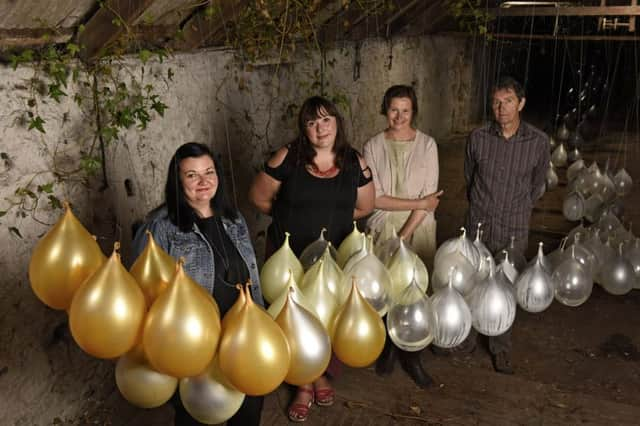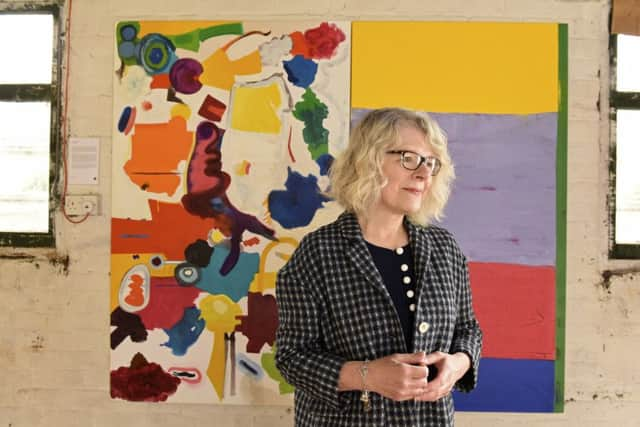Art review: Empire, Montrose


There’s a harled, two-storey building that, at first, might be mistaken for a house were it not for some odd quirks of scale and a large door that suggests a workshop. Adjoining is a long, low and narrow sequence of haphazard additions.
Inside is a complete revelation. This is the Old Rope Works, a building dating from 1789 that was once home to the Montrose Rope and Sail Company. The company is a still-flourishing enterprise that was founded to serve the Angus fishing industry and these days creates bespoke tarpaulins and kit bags, for the offshore industry, from modern premises nearby.
Advertisement
Hide AdThe Rope Works is currently leased by Kim Canale. She is an enterprising Montrose-raised artist who returned to the town from London and set up Wall Projects, a studio and gallery that supports both her own work and that of other artists, including young graduates from Duncan of Jordanstone College of Art where she once studied.


Upstairs is Canale’s studio and a large, timber-beamed attic floor that provides a handsome, atmospheric gallery. Downstairs, though, is something else altogether: the half-lit shop floor of the atmospheric former rope factory, the impressive length of which was necessary for the craft of rope-making and the scale of sail. Abandoned sewing machines and work tables still litter the place. Some walls are hung with tarpaulins. Chalk mark calculations and packs of industrial needles remind you of the many hands that have worked here.
The flooring gives way, at its farthest reaches, to a dirt floor and the dusty skylights at the far end of the building have been penetrated by ivy. If this already feels like a sinister fairy tale, then buried within the fabric of the building is ambiguous treasure. What looks like faded, white-washed timber, lying half-exposed in the rubble walls is not ordinary wood but historic whale bone. The history of the town, a history of seafaring, fishing, trading, whaling, and, as this fascinating exhibition reveals, slavery, is not just marked on the skin of this building but embedded in its very skeleton.
Upstairs, the SSA’s loose chosen theme of Empire is recalled in different ways by a disparate group of artists. Kate Clayton, a livewire of an artist who is currently gaining deserved attention for a project in Dundee celebrating those silver-haired women who have resisted the pressure to dye their hair, explores the archive of the Blairgowrie photo studio David Wilson.
On a suspended perspex shelf Jenny Pope has placed a host of little ceramic vessels, half of which show the traces of long-evaporated tea. The other half hold desiccated poppy heads, a reference to the opium wars, which were the bitter corollary of British desire for tea and other Chinese products in the 19th century.
Elaine Allison’s comic print shows sailing ships afloat on the iced surface of a Linzer biscuit the name of which shifted according to the political winds are blowing. These days you might know it better as an Empire or German biscuit.
Advertisement
Hide AdBut it is downstairs on the factory floor that the show really comes to life, with a series of works in which the artists really stretch their muscles and respond to the extraordinary setting. Alan Bond’s Jetty is a simple solution to the condition of the building: placing scaffolding boards from Steptoe’s Yard in nearby St Cyrus, where the going underfoot is unsafe. But walking along it into darkness one begins to understand the reach of the seafaring tradition and a sense of the building, not as an interior, but as a point of departure. Above it, hangs Meltwater a sweep of half-filled and graphite-smeared balloons by Juliana Capes, that have a shabby beauty just as they remind us that Empire was driven by the desire to exploit others for their natural resources.
In a chilly back room that once held the factory kitchen, Deirdre Robertson has placed a giant hangman’s noose. It marks 50 years since the abolition of the death penalty. Neil Paton of Montrose Rope and Sail, who had never made one before, tied the noose for the artist using skills he had learned from his father.
Advertisement
Hide AdIf Montrose boats were involved in traditional east coast trades such as textiles and fish, historical research shows that some of them also carried human cargo. The boats known as ‘snows’, would carry goods such as salmon and processed tobacco to European ports and from there carry on to West Africa where their empty holds were filled with a human cargo destined for slavery in the West Indies. At its peak up to 30 boats would have plied this triangular trade, which of course was by no means unique to this small port.
Carolyn Scott’s audio installation Considered Cargo features the novelist James Robertson and the historian Iain Whyte reading letters and commercial documents from the archive which document North East Scotland’s links to the slave trade. This is no exercise in hand-wringing but a clear-minded and chilling piece that is justified by the historical record. But, to hear the dispassionate words of commerce in such an atmospheric setting and to understand the lengths to which that word rope might truly and terribly extend is an important moment indeed.
When Robertson was researching his 2003 novel Joseph Knight, about a real-life court case in which a former slave brought to a Scottish estate who petitioned the Court of Session for his freedom, he was one of only a handful of cultural figures who were clearly addressing Scotland’s role in slavery. Empire shows that are many more stories to tell, but above all, in this wonderful atmospheric building, it reminds us that there are places whose very fabric tells us tales without the need for words.
• Until August 29